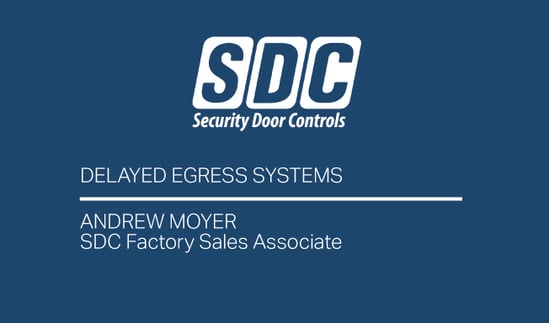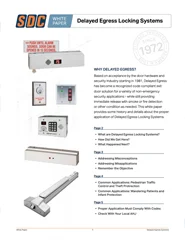
An incident earlier this year highlights misconceptions about using or not using Delayed Egress on emergency exit doors.
On New Year’s Day at Salt Lake City International Airport, a Utah man died after he breached double doors at an airport emergency exit stairway in the secure area of the passenger terminal, ran across the tarmac, and crawled into the engine of a plane awaiting deicing. His family said he had a history of mental illness and suspect he was experiencing a manic episode.
Prior to his gaining access to the runway through the stairway double doors, he was thwarted in several attempts to gain access to the jetway at a gate door secured by an SDC EMLock® paired with an exit bar and door trim. It should be noted that SDC’s electrified hardware solutions are used on every jetway gate door at this airport.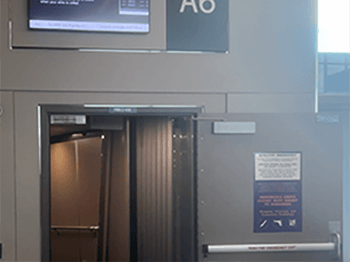
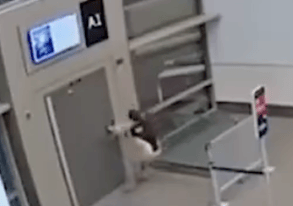
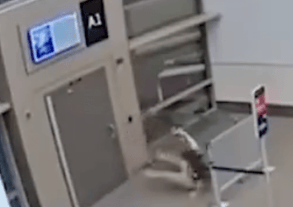
Airport security officials said it took ten minutes from when the man opened the door until they got to him inside the engine. However, they said staff was monitoring him the entire time from use of their high-definition surveillance system – purported to be the most advanced installation in domestic aviation with 3,000 cameras trained on virtually every square foot of the facility. Although officials were able to remove him from the engine, efforts to revive him were unsuccessful.
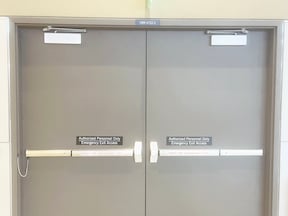
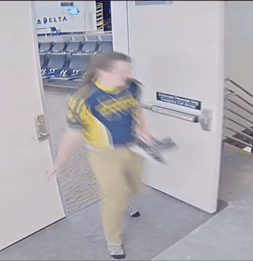
“It does seem a little weird that a passenger could push a door open and another door and end up on the airfield," said Director of Salt Lake Airports, Bill Wyatt.
We agree. How does someone quickly exit an emergency door onto a runway without being apprehended immediately? Wyatt asserts there is a bigger safety issue at play: the emergency doors can't be locked closed because if there's a fire, an explosion, or an active shooter, people need to get out immediately.
A Common Misconception
This is one of the more common misconceptions we’ve encountered about using Delayed Egress Systems: that exit from a building is delayed during an emergency – think smoke or fire detection - endangering lives. In this case, the likelihood of an active shooter or explosive device in the secured area of an airport terminal is extremely unlikely. The past few decades have seen the implementation of proven, comprehensive layers of security in our nation’s airports. Delayed Egress Systems can be found in use at every major airport as one of these layers. Why?
Delayed Egress is a Fail-Safe Electric Locking System
As the basic electric locking circuit wiring diagram shows, delayed egress is first and foremost a fail-safe electric locking system. 
This means that if power to the system is ever lost for whatever reason, the fail-safe electric lock will release immediately, allowing for egress without delay in an emergency. The diagram also shows the system as being connected to the fire panel release of an alarm system, again providing for uninhibited egress in an emergency. Further, if a fire actually occurs in the alarm, power supply or controller systems causing failure, the fail-safe lock will also release.
Should a facility manager have concerns about an fire, explosion or active shooter situation within a building secured with a Delayed Egress System on a perimeter door, an optional legal release may be included for immediate release of the lock by authorized personnel using the “OPTIONAL AUTHORIZED RELEASE” input as noted in the previous wiring diagram.
Delayed Egress System Summary
Here’s a review summary on what Delayed Egress Systems are and how they’re used: Delayed Egress Systems are door locking solutions designed for use in non-emergency situations to prevent a door from opening immediately when egress is attempted. Fire, Life Safety and Building codes usually require that occupants can freely exit in a single motion to unlatch the door without special knowledge, effort, or the use of a key or tool. Delayed Egress systems are an exception to the rule. 
Typically used on exit doors, when unauthorized egress is initiated in the locked mode, Delayed Egress locks delay egress through the door for 15 or 30 seconds. Meanwhile, the person exiting must wait while personnel or security respond. The door unlocks after 15 seconds have elapsed, permitting egress. A signal from the fire life safety system will release the lock for uninhibited egress in an emergency.
Delayed Egress systems are used to control pedestrian traffic in government, public and transportation facilities, including airport jetways and tarmacs. They provide theft protection of merchandise, technology and other valuables such as art and museum artifacts in stores, warehouses, art galleries, museums and technology facilities. Delayed Egress locks also restrict movement of wandering patients in senior assisted living, psychiatric, and drug rehab facilities and guard against infant abduction in hospital nurseries.
Control Pedestrian Traffic in Airports
A common application is to control pedestrian traffic in airports. The purpose is usually to “prevent unauthorized access/egress and to control and limit traffic effectively in designated areas.”1 Chances are, you’ve probably heard a door alarm, siren or audible alert message at an airport when someone tried to enter or exit a terminal door enabled with a Delayed Egress lock.
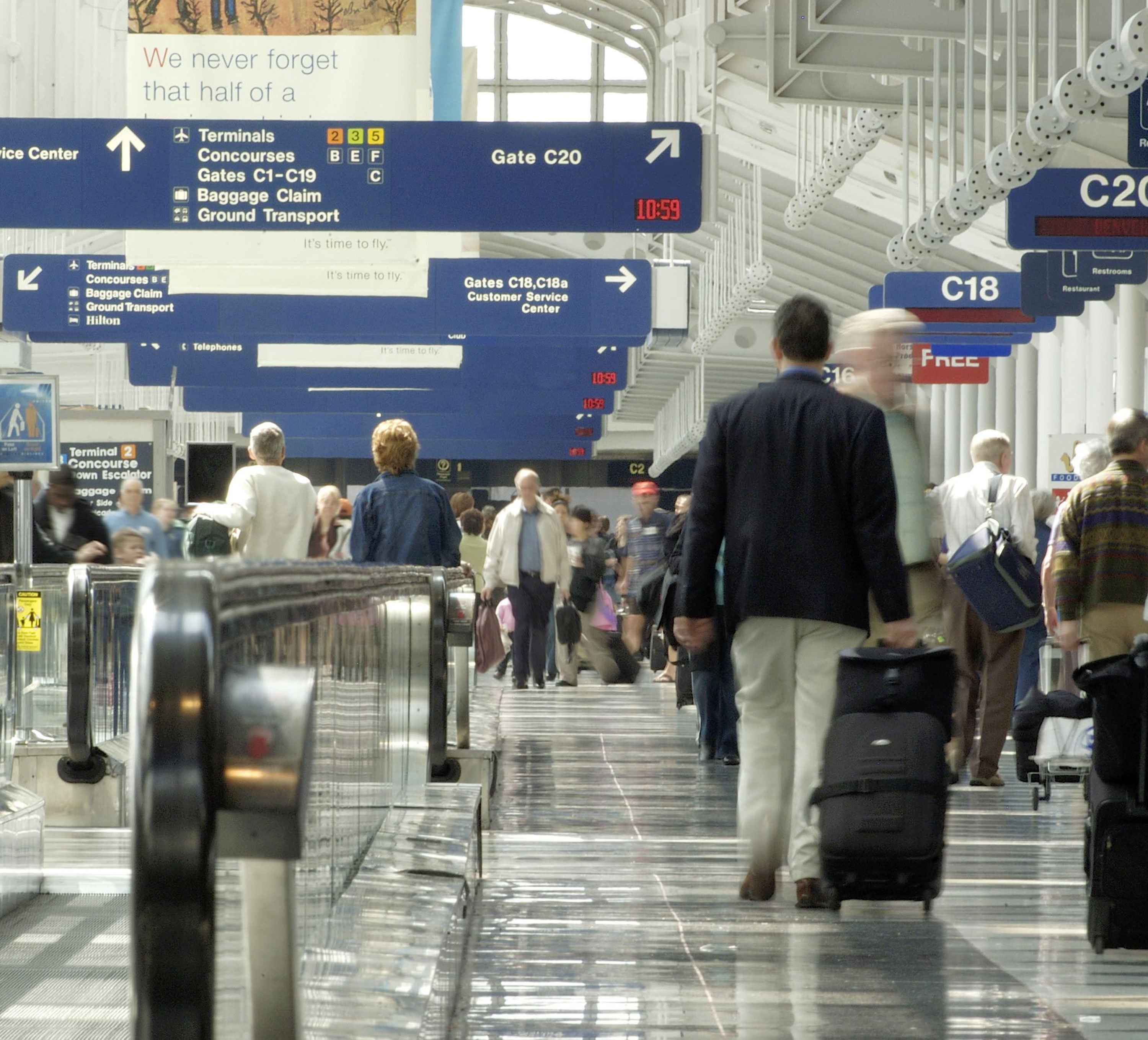
Ultimately, placing delayed egress systems on double doors at airport emergency exit stairways like the one the man successfully breached in the SLC airport, could have caused him to try other emergency exits stairways without success – providing airport security personnel precious, additional time to apprehend him.
Proper Application Must Comply With Codes
A Delayed Egress System must comply with all national and regional building and fire life safety codes and the NFPA 101 section on Special Locking Arrangements. Some common requirements are:
- The delayed egress lock must be approved or listed and shall be permitted for installation on doors serving occupancy levels as specified per prevailing code (consult your AHJ for complete details).
- The doors must unlock upon activation of an automatic sprinkler system or automatic fire detection system.
- The doors must unlock upon loss of power controlling the delayed egress locking device.
- The delayed egress locks shall be unlocked by a signal from the fire command center.
- Applying no more than 15 lbs of pressure will start an irreversible process to unlock the door. Nuisance delay varies per code.
- An alarm must sound at the opening upon initiation of the release process.
- A sign must be applied to the door.
Check With Your Local AHJ
As always, we strongly recommend checking with the local AHJ regarding code compliance before considering or installing any type of Delayed Egress System to ensure the proper application will meet your specific requirements.

For more Delayed Egress product information and resources, visit https://sdcsecurity.com/Delayed-Egress-Innovation.htm
Watch our Delayed Egress Video to learn more:
For a comprehensive list of Code Compliant Operation Modes that apply to our Delayed Egress Systems refer to page 9 of our Delayed Egress Hardware White Paper at sdcsec/com/whitepapers-delayedegress.
Resources Used for This Blog
1 From “Electronic Locking Systems” by John L. Schum: Considered to be the Industry Bible for Electronic-Electric Locks - https://www.amazon.com/Electronic-Locking-Devices-Security-Technicians/dp/0409901253
KJZZ.com –“Salt Lake airport director defends technology, response time despite security breach” - https://kjzz.com/news/local/salt-lake-airport-director-defends-technology-response-time-despite-security-breach-kyle-efinger-killed-bill-wyatt-director-of-airport-operation-treber-andersen
Twitter.com – “Surveillance footage captured on January 1, 2024, at Salt Lake City International Airport” - https://twitter.com/Morbidful/status/1748013897481601182
KVTH.COM – “Utah man dies after crawling into plane engine at airport” - https://www.ktvh.com/utah-man-dies-after-crawling-into-plane-engine-at-airport


